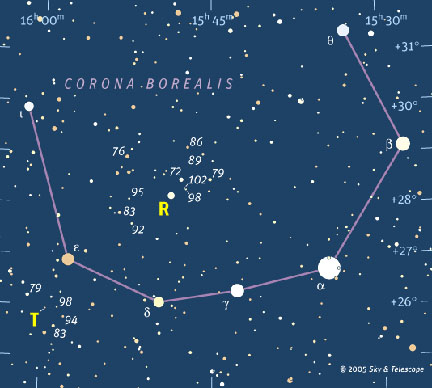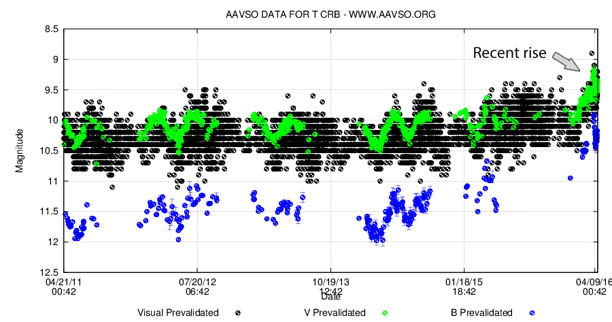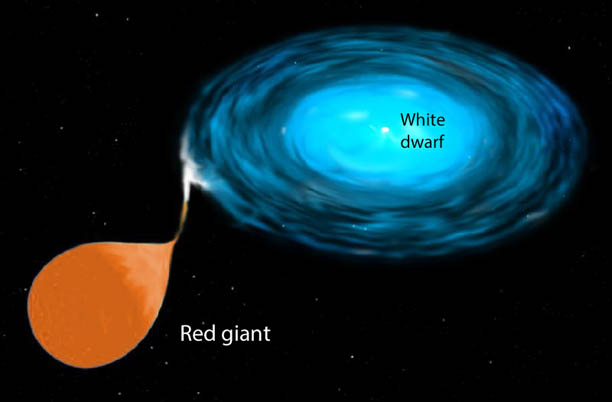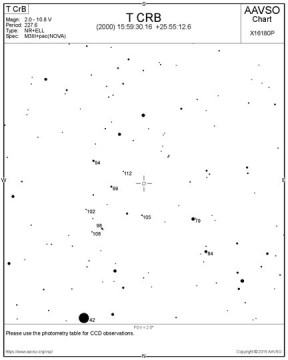The recurrent nova T Coronae Borealis last made a splash just after World War II. Does its current restive state hint at an imminent outburst?

S&T
We've been struggling lately in northern Minnesota to get past winter and get on track with spring. That's why I was so surprised to step out my door the other night and hear the frogs in full, throaty chorus.
Variable stars can be like that, too. You can watch a particular variable for months, even years, and its brightness might fluctuate by a few tenths of a magnitude. Then all of a sudden, it blows up like a firecracker when you least expect.
Take T Coronae Borealis (T CrB). It's one of only about 10 stars in the entire sky classified as a recurrent nova, with two recorded outbursts to its name. Normally, the star slumbers at 10th magnitude, but on May 12, 1866, it hit the roof, reaching magnitude +2.0 and outshining every star in Corona Borealis before quickly fading back to obscurity. Eighty years later, on February 9, 1946, it sprang back to life, topping out at magnitude +3.0.
Many variable star observers include it in their nightly runs because it's easy to find 1° south-southeast of Epsilon (ε) in Corona Borealis and only requires a 3-inch telescope. Not to mention the huge payoff should you happen catch the star during one of its rare explosions. Famed comet hunter and variable lover Leslie Peltier faithfully kept an eye on T CrB for over 25 years, hoping to catch it in outburst. On that fateful February morning in 1946 he'd set his alarm clock for 2:30 a.m., planning to check in on several favorite stars before dawn. But when he awoke and looked out the window, he felt a cold coming on and allowed himself instead to go back to bed. Big mistake. That very morning, T CrB came back to life.
In his book Starlight Nights, Peltier writes:
"I alone am to blame for being remiss in my duties, nevertheless, I still have the feeling that T could have shown me more consideration. We had been friends for many years; on thousands of nights I had watched over it as it slept, and then it arose in my hour of weakness as I nodded at my post. I still am watching it but now it is with a wary eye. There is no warmth between us any more."

AAVSO
T stayed under the radar for the next 69 years, holding steady around magnitude +10.2–10.3. That began to change in February 2015, when it inched up to +10.0 and remained there until early February this year. That's when things kicked into high gear with the star steadily growing brighter from late winter through early spring to reach its current magnitude of ~9.2.
Alongside the brightening trend, T's become bluer as well. Astronomers describe its recent unprecedented activity as a star entering a "super active" state. This last happened in 1938, eight years before its last great outburst.
T CrB followers can't help but wonder if the next night we look up, Corona Borealis will twinkle with "new" second-magnitude star.

NASA
Recurrent novae are similar to nova and dwarf nova types but with unique characteristics that set them apart. All three types occur in close binary stars and involve mass transfer from a normal star to a small but gravitationally powerful white dwarf. Classical novae have only been seen in outburst once and typically brighten by 8-15 magnitudes before slowly fading back to their pre-outburst brightness. Dwarf novae outburst frequently — every 10-1,000 days — with moderate increases of 2-6 magnitudes. Recurrent novae fall in between and typically vary by 4-9 magnitudes over a 10-100 year period.

AAVSO
T CrB has two components: a red giant star in a close, 227-day orbit with a planet-sized white dwarf. Material spills from the giant and accumulates in an accretion disk around the dwarf. Some of that gas gets funneled down to the dwarf’s surface, becomes compacted and heated, and eventually ignites in a spectacular thermonuclear explosion. We see the results as a sudden brightening of the star.
It's even theoretically possible for enough matter to accumulate on the dwarf to push it past the 1.4 solar mass Chandrasekhar Limit, forcing the entire star to burn explosively as a Type Ia supernova. At T CrB's 2,500 light-year distance, it would easily cast shadows!
Maybe we'll have to wait until 2026 (80 years after the 1946 eruption) for T's next upheaval. Or maybe not. Either way, let Leslie Peltier's story serve as a cautionary tale. Keep a close eye on this star every clear night, and expect surprises.
 9
9









Comments
Anthony Barreiro
April 20, 2016 at 2:15 pm
Thanks for the heads up, and the chart.
You must be logged in to post a comment.
Bob KingPost Author
April 20, 2016 at 4:28 pm
You're welcome, Anthony. It's such an easy star to follow especially now that's it gotten brighter.
You must be logged in to post a comment.
Bob
April 20, 2016 at 11:55 pm
Thanks for the information on T CrB--and the quote from Leslie Peltier.
...Bob
You must be logged in to post a comment.
Bob KingPost Author
April 22, 2016 at 12:04 pm
You're welcome, Bob-Patrick. Anytime I can quote Leslie Peltier it brings back good memories of reading and so thoroughly enjoying his book "Starlight Nights". It inspired me to start observing variable stars.
You must be logged in to post a comment.
William-Moser
April 22, 2016 at 6:38 pm
Great article, Bob. I was wondering as I read it if you would mention Leslie Peltier, and you didn't let me down. I've read Starlight Nights many times, and I think the only part I liked better than his T Coronae Borealis story was the one about how he reported his first comet discovery. Clear Skies.
Bill Moser
You must be logged in to post a comment.
Bob KingPost Author
April 24, 2016 at 11:31 pm
Thanks William! I wonder how many amateurs were inspired to become comet hunters because of his book.
You must be logged in to post a comment.
April 23, 2016 at 8:39 am
I had a look at T this morning at about 10 UT, and it appeared brighter than the 9.9 mag. star, and and nearly equal to or just barely fainter than the 9.4.
Will be keeping an eye on this one - for another decade, if necessary! Thanks for the post.
Doug Z
You must be logged in to post a comment.
Bob KingPost Author
April 24, 2016 at 11:33 pm
OwlEye,
Thanks for the update. Your observation fits right in with what other observers are seeing and reporting on the AAVSO website.
You must be logged in to post a comment.
April 28, 2016 at 12:09 pm
I have a few more questions for you that are not particularly related to this post - could you email me at [email protected] so i can get your email address? Thanks!
DZ
You must be logged in to post a comment.
You must be logged in to post a comment.